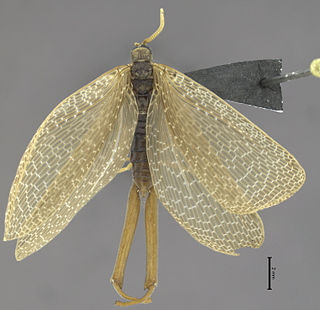 W
WAustromerope is a genus of forcepfly which contains only two known species, Austromerope poultoni from Western Australia, and the South American Austromerope brasiliensis. They are small scorpionflies, with large forceps-like structures at the tail and two pairs of wings. Only adults and eggs from captured adults are known - no larval stage has been seen. Much of the biology of these insects is not known, due to their secretiveness and rarity.
 W
WAustromerope brasiliensis is one of only two living representatives of the genus Austromerope. It is apparently endemic to Brazil, with large forceps-like structures at the tail and two pairs of wings. Only adults are known - no larval stage has been seen.
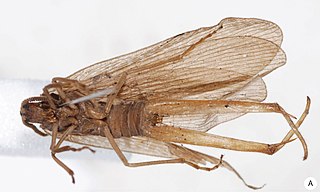 W
WAustromerope poultoni is one of only two representatives of the genus Austromerope, and the only member of the family Meropeidae in the Eastern Hemisphere. It is endemic to Western Australia, typically around 20mm long, with large forceps-like structures at the tail and two pairs of wings. Only adults and eggs from captured adults are known – no larval stage has been seen. It is found in a variety of habitats, including woodland, Jarrah forest, and sand plain vegetation.
 W
WBittacus strigosus, the striped scorpionfly, is a species of hangingfly in the family Bittacidae. It is found in North America.
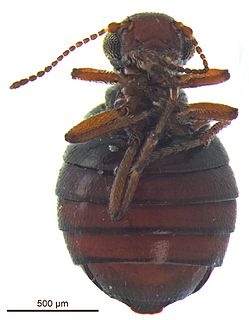 W
WCaurinus is a genus of snow scorpionflies in the family Boreidae. There are at least two described species in Caurinus.
 W
WThe Choristidae are a small family of scorpionflies known only from Australia. Their larvae are found in moss mats.
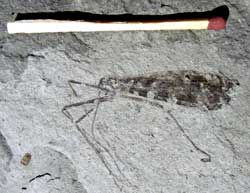 W
WCimbrophlebia is an extinct genus of Mecoptera which existed from the Jurassic to the Eocene period.
 W
WDicerapanorpa is a genus of scorpionflies endemic to China. They can be easily recognized by the two anal horns on the posterior margin of the sixth tergum in males.
 W
WEomeropidae is a family of aberrant, flattened scorpionflies represented today by only a single living species, Notiothauma reedi, known from the Nothofagus forests in southern Chile, while all other recognized genera in the family are known only as fossils, with the earliest definitive fossil known from Liassic-aged strata, and the youngest from Paleogene-aged strata.
 W
WBittacidae is a family of scorpionflies commonly called hangingflies or hanging scorpionflies.
 W
WHarpobittacus is a genus of hangingfly or scorpionfly of the family Bittacidae found in Australia.
 W
WHarpobittacus australis is an Australian species of insect in the family Bittacidae found in the southern states of New South Wales, Victoria, South Australia and Tasmania.
 W
WHarpobittacus septentrionis is a species of insect in the family Bittacidae found on the north-east coast of Australia.
 W
WLichnomesopsyche is an extinct genus of mesopsychid mecopteran which existed in what is now China during the middle Jurassic period. It was found in the Daohugou Bed. It was named by Ren Dong, Conrad C. Labandeira and Shih ChungKun in 2010. Three species have been named, which can be distinguished by their differing male genitalia.
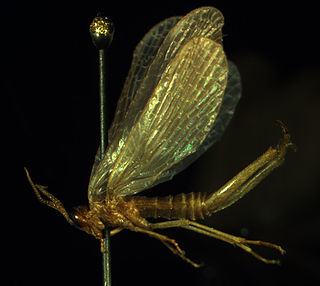 W
WMerope tuber, the earwigfly or forcepfly, is the only species in the genus Merope, and the only living member of the family Meropeidae in North America. It occurs throughout the east from Ontario to Georgia, and west to Kansas. Recently the insect has also been found in Florida. This insect's most distinguishing feature is the segmented cerci on the male abdomen. The function of these is not known, but they may be used during courtship. Much is unknown about the adults, which are nocturnal and secretive, sometimes found under logs or in malaise traps near streams, or attracted to lights at nighttime. No M. tuber or Meropeid larvae have been identified. The insect is characterized by long wings with many veins and no ocelli. There is a region of interlocking sclerites that holds the jugum and scutellum on the middle thoracic segment together. This may be used to keep the wings together when pushing up through dirt. A similar apparatus is found in cicadas and ground-dwelling beetles, so it may be that the winged adults dig in soil. The flat appearance of the insect suggests that the insect dwells close to the ground in fissures and other small ground openings, as does the lack of ocelli.
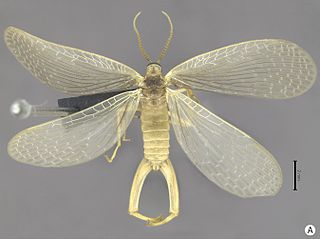 W
WMeropeidae is a family of tiny scorpionflies within the order Mecoptera with only three living species, commonly referred to as "earwigflies". These include the North American Merope tuber, the Western Australian Austromerope poultoni, and the recently discovered South American A. brasiliensis. The biology of these species is essentially unknown, and their larvae have never been seen. The disjunct distribution suggests a common origin before the breakup of the ancient supercontinent of Pangaea. There are two undisputed extinct genera, Boreomerope antiqua known from an isolated wing found in the Middle Jurassic Itat Formation of Siberia and Burmomerope with three species from the Cenomanian aged Burmese amber. As such, the extant members of this family can be considered living fossils. These insects are also of interest due to their presumed basal position in the order Mecoptera. Thaumatomerope with four described species all from the Madygen Formation in Kyrgyzstan has historically sometimes been included within the family, it was placed into its own monotypic family, "Thaumatomeropidae." in 2002.
 W
WNotiothauma is the sole living genus in the scorpionfly family Eomeropidae. The genus is monotypic with a lone species Notiothauma reedi which is native to the Valdivian temperate rain forests of central Chile, especially the forests with Nothofagus stands. N. reedi is flattened with a notedly cockroach-like in appearance. They are nocturnal and inhabit the forest floor where the adults feed on plants and decaying animals. The larvae are still unknown. Because this is the last extant species of Eomeropidae, N. reedi can be characterized as a living fossil taxon.
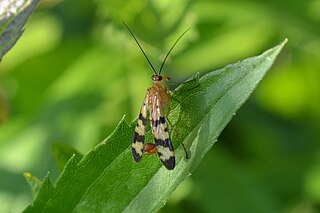 W
WPanorpa americana is a species of common scorpionfly in the family Panorpidae. It is found in North America.
 W
WPanorpa helena is a species of common scorpionfly in the family Panorpidae. It is found in North America.
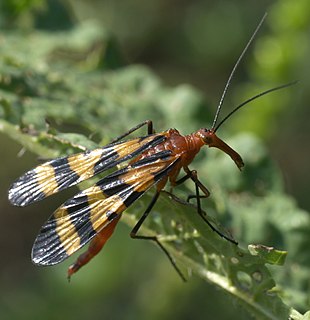 W
WPanorpa nuptialis is a species of common scorpionfly in the family Panorpidae. It is also found in North America.
 W
WThe Panorpidae are a family of scorpionflies containing more than 480 species. The family is the largest family in Mecoptera, covering approximately 70% species of the order. Species range between 9–25 mm long.